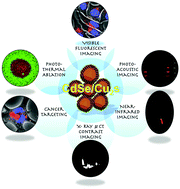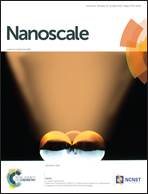Plasmonic fluorescent CdSe/Cu2S hybrid nanocrystals for multichannel imaging and cancer directed photo-thermal therapy†
Abstract
A simple, crude Jatropha curcas (JC) oil-based synthesis approach, devoid of any toxic phosphine and pyrophoric ligands, to produce size and shape tuned CdSe QDs and a further copper sulfide (Cu2S) encasing is presented. The QDs exhibited excellent photoluminescent properties with narrow band gap emission. Furthermore, the Cu2S shell rendered additional cytocompatibility and stability to the hybrid nanomaterial, which are major factors for translational and clinical applications of QDs. The nanocomposites were PEGylated and folate conjugated to augment their cytoamiability and enhance their specificity towards cancer cells. The nanohybrids possess potentials for visible, near infrared (NIR), photoacoustic (PA) and computed tomography (μCT) imaging. The diverse functionality of the composite was derived from the multi-channel imaging abilities and thermal competence on NIR laser irradiation to specifically actuate the photo-thermal ablation of brain cancer cells.


 Please wait while we load your content...
Please wait while we load your content...